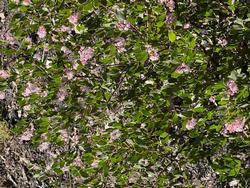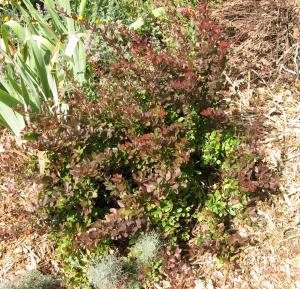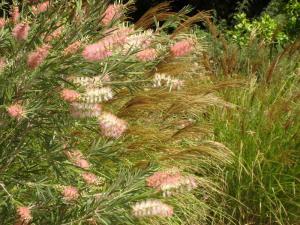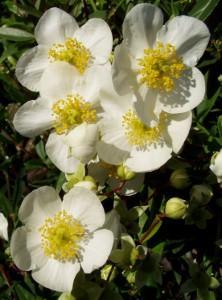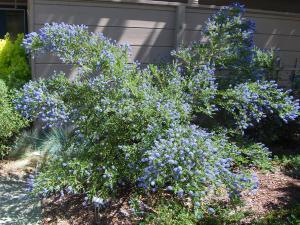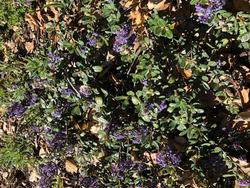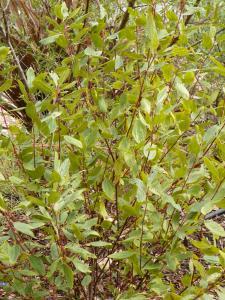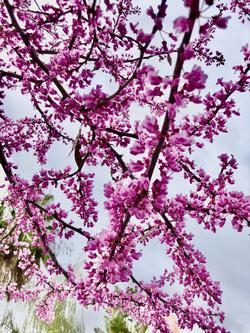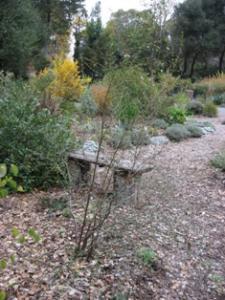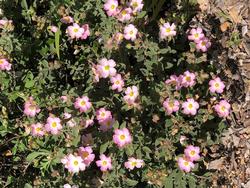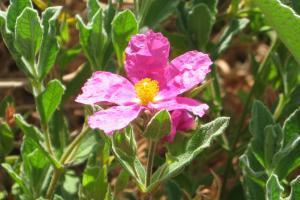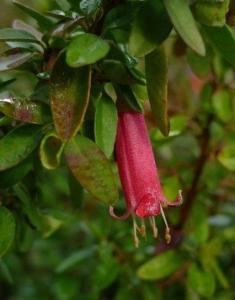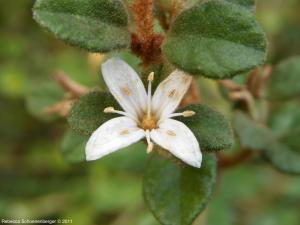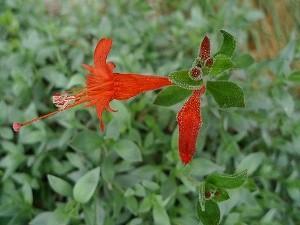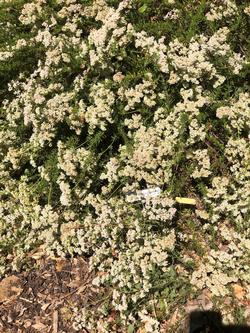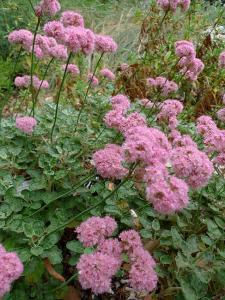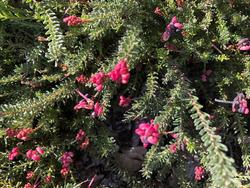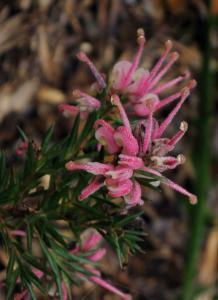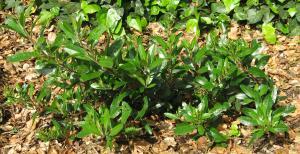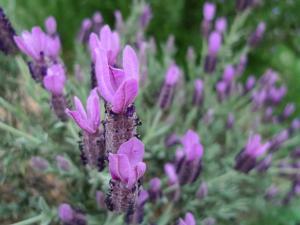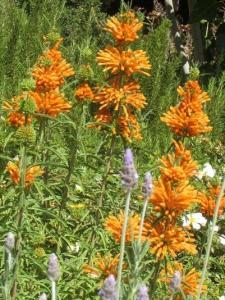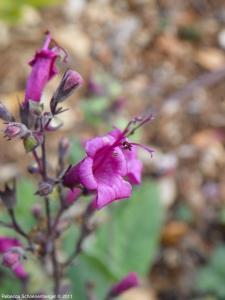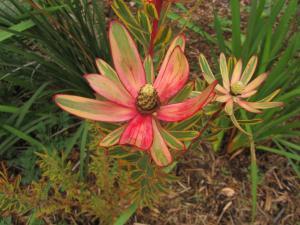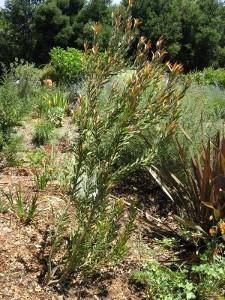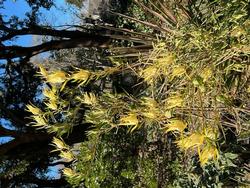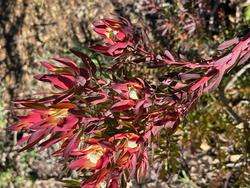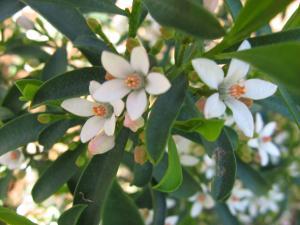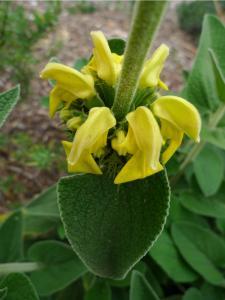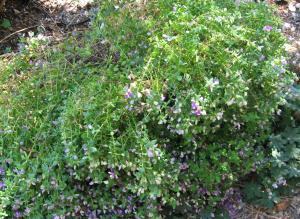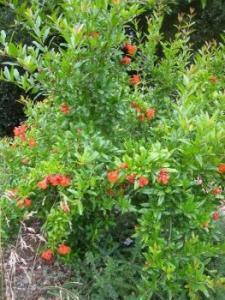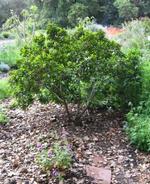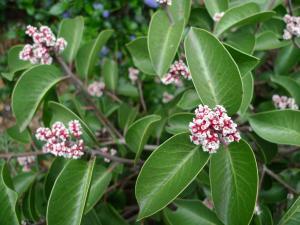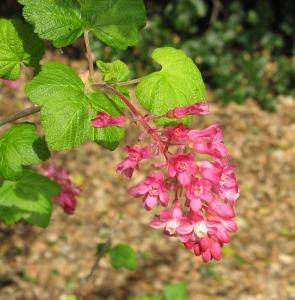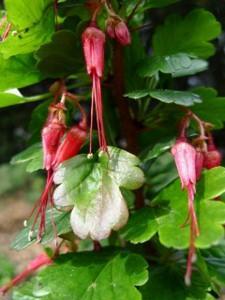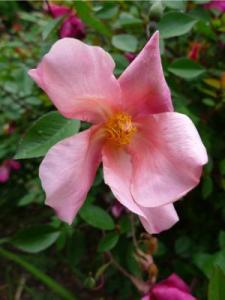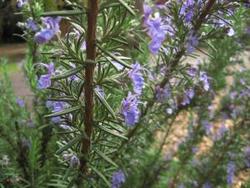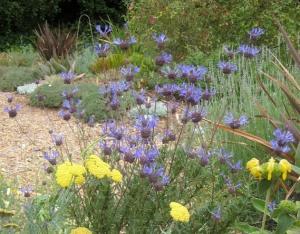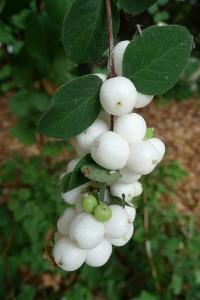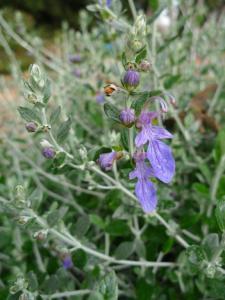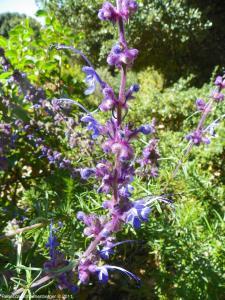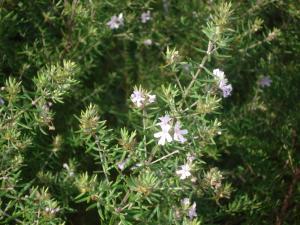Water Wise Plants
Here's a full list of all our water wise plants. You can also view an image gallery, or view the plants by categories.
Arctostaphylos densiflora ‘Howard McMinn’
Pronunciation
ark-toe-STAF-i-los den-si-FLOR-us
Common Name
Manzanita ‘Howard McMinn’
Plant Type
Shrub
Mature Size
5-7 ft tall x 6-10 ft wide
Water Requirements
Very Low: water deeply several times a summer
Sun/Shade Requirements
Full to half sun
Wildlife
Flower Color
Whitish pink
Maintenance- Design- Planting Tips
California native Arctostaphylos ‘Howard McMinn’ is reputed to be the manzanita most tolerant of typical garden conditions. Manzanitas in general need excellent drainage. In heavy clay soils, be careful not to over water or over fertilize.
If the tips of Arctostaphylos branches are pruned, this large shrub will become very dense and make a good privacy screen. Removing the interior stems and leaves instead exposes the interesting red bark. The latter is a good approach for making the shrub more of a focal point instead of a background plant. PADG notes: PADG planted three ‘Howard McMinn’ manzanitas at the entrance of the Water Wise Garden. They have struggled there over the years, damaged by foot traffic and the occasional joy rider. |
Berberis thunbergii ‘Crimson Pigmy’
Pronunciation
BER-ber-is thun-BERG-ee-a
Common Name
Japanese Barberry
Plant Type
Shrub
Mature Size
2 ft x 3 ft
Water Requirements
Low: water every three weeks until the root ball is wet
Sun/Shade Requirements
Full to half sun
Wildlife
Flower Color
Yellow
Where to See
Maintenance- Design- Planting Tips
Berberis thunbergii ‘Crimson Pigmy’ adds great dramatic foliage color to the garden. When planted in full sun, the small leaves on this spiny, naturally graceful plant are a deep purplish red. The purple red leaf color contrasts nicely with the yellow flowers that appear in spring. If grown in semi-shade, the foliage takes on a greener cast. In the fall, the leaves turn a vivid red before falling. The small size makes this plant an easy addition to any garden.
PAGD notes: In our original planting, three pygmy barberries were planted along the front bed. Unfortunately, only one plant survived, but it is doing well. Barberries are slow growing plants and it took a while for them to get established in the garden. More frequent watering would have benefited these plants. |
Callistemon ‘Canes Hybrid’
Pronunciation
kal-is-TEM-on
Common Name
Bottlebrush
Plant Type
Shrub
Mature Size
8 ft. to 10 ft. wide and tall
Water Requirements
Low: water every three weeks until the root ball is wet
Sun/Shade Requirements
Full to half sun
Wildlife
Flower Color
Soft pink
Where to See
Maintenance- Design- Planting Tips
Callistemon ‘Canes Hybrid’ is a beautiful shrub that adds height and structure to the perennial garden, with soft pink flowers that bloom repeatedly throughout the summer. The cultivar ‘Canes Hybrid’ is smaller and has softer, greyer foliage than the more common red Callistemon citrinus.
Callistemon are very adaptable plants for Santa Clara Valley gardens and are attractive to hummingbirds. The many cultivars of Callistemon range from tree-size to shrub-size to ground cover height. PADG notes: The Callistemon is pruned and shaped to a shrub and is has been planted next to Miscanthus sinensis ‘Yaku Jima’ as seen in the photo. |
Carpenteria californica
Pronunciation
kar-pen-TIER-ree-uh kal-ih-FOR-nik-uh
Common Name
Bush Anemone
Plant Type
Shrub
Mature Size
6 ft. tall and 4 ft. wide or possibly larger
Water Requirements
Low: water every three weeks until the root ball is wet
Sun/Shade Requirements
Full to half sun
Wildlife
Flower Color
White
Where to See
Maintenance- Design- Planting Tips
Carpenteria is an evergreen shrub and works well as a background shrub or in mixed plantings under oaks. This shrub has pretty leaves and cheery ‘egg over easy’ flowers. It is a UC Davis Arboretum All-Star and a California native.
Carpenteria californica is a flexible plant, tolerating light to moderate water and full sun to partial shade. One drawback of this plant is the brown leaves don’t always drop off in summer. If this shrub is in a very visible spot, it may be desirable to cut off the brown leaves for a cleaner appearance. |
Ceanothus ‘Concha’
Pronunciation
see-a-NO-thus
Common Name
California Wild Lilac ‘Concha’
Plant Type
Shrub
Mature Size
6-8 ft tall x 6-8 ft wide
Water Requirements
Very Low: water deeply several times a summer
Sun/Shade Requirements
Full to half sun
Wildlife
Flower Color
Blue
Where to See
Maintenance- Design- Planting Tips
Ceanothus ‘Concha’ is a California native plant with rose colored buds that open to cobalt blue flowers in late winter or early spring. Leaves are small and a deep dark green.
‘Concha’ is one of the best Ceanothus cultivars for Santa Clara County. It is more adaptable to typical garden environments than many other Ceanothus, tolerating heavy clay soil, drought, or summer watering. Overwatering will shorten the life of any Ceanothus so be sure to allow the soil to dry between waterings. |
Ceanothus maritimus ‘Valley Violet’
Pronunciation
see-an-OH-thus muh-RIT-tim-mus
Common Name
Maritime ceanothus
Plant Type
Shrub
Mature Size
1'-3' high x 3'-8' wide
Water Requirements
Low: water every three weeks until the root ball is wet
Sun/Shade Requirements
Full sun
Wildlife
Flower Color
Maintenance- Design- Planting Tips
Ceanothus maritimus ‘Valley Violet’ is a California native and a UC Davis Arboretum All-Star. This low growing Ceanothus has a wide spread and can be an effective ground cover. It has dark, blue-green foliage that contrasts nicely with its purple flowers, which bloom from winter into spring. Be aware that all Ceanothus develop buckthorns as they age that can be very sharp.
PADG notes: Several varieties of Ceanothus were planted several years ago in the Native Bed at the Palo Alto Demonstration Garden. As of 2022, Ceanothus maritimus ‘Valley Violet’ is doing the best in the group. It is very drought tolerant and is living up to its All-Star status with the garden’s dry season irrigation cycle. Established plants are watered once every three weeks with drip lines. |
Ceanothus x pallidus ‘Marie Simon’
Pronunciation
see-an-OH-thus PAL-id-us
Common Name
Wild Lilac ‘Marie Simon’
Plant Type
Shrub
Mature Size
Up to 6 - 8 ft. high and wide
Water Requirements
Low: water every three weeks until the root ball is wet
Sun/Shade Requirements
Full to half sun
Wildlife
Flower Color
Where to See
Maintenance- Design- Planting Tips
Ceanothus x pallidus ‘Marie Simon’ is a cross between a native Ceanothus and another unknown plant, and is a UC Davis Arboretum All-Star. It looks quite different from a native Ceanothus. It is semi-deciduous, with red stems and light green leaves, and its flowers are a delicate pink instead of the blue more typical for Ceanothus.
PADG notes: Online photos show a plant covered with pink flowers but that hasn’t been the case at the Demonstration Garden. The flowers have been pretty but sparse and the plant does not look vigorous. It has been in the garden for several years and is still a non-performer. We can’t recommend this plant for low water gardens in the Palo Alto area. |
Cercis occidentalis
Pronunciation
SIR-sis ok-sih-den-TAY-liss
Common Name
Western Redbud
Plant Type
Shrub
Mature Size
12-20 ft. tall and wide
Water Requirements
None: avoid summer water
Sun/Shade Requirements
Full to half sun
Wildlife
Flower Color
Magenta
Where to See
Maintenance- Design- Planting Tips
Western redbud's magenta flowers are quite a sight in the early spring. After blooming the small multi-trunked tree or large shrub has pretty heart-shaped leaves. This California native and UC Davis Arboretum All-Star is an excellent choice for a small space or an edge of woodland design. After the plant blooms, Western redbud sets distinctive seedpods.
Like many natives, this plant needs good drainage, so consider planting it on a mound. Avoid summer water. Cercis can be pruned over the winter to open up the branching structure to give the plant a more tree-like appearance. |
Cercocarpus betuloides
Pronunciation
ser-koe-KAR-pus be-tull-OY-dees
Common Name
Mountain Mahogany
Plant Type
Shrub
Mature Size
5-12 ft. tall and wide, adult size can vary
Water Requirements
None: avoid summer water
Sun/Shade Requirements
Full to half sun
Wildlife
Flower Color
Small yellow flowers
Where to See
Maintenance- Design- Planting Tips
Cercocarpus is an evergreen shrub that is useful for screening, as informal hedging, or can be pruned into a small, elegant tree. As a California native from the foothills, it can get by on little to no water once established. It is on the UC Davis Arboretum All-Stars list.
PADG notes: This slow growing plant has not had problems with pests or diseases. We have pruned this Cercocarpus to have a more open form, so it is now a very attractive, airy shrub. |
Cistus x argenteus ‘Silver Pink’
Pronunciation
SIS-tus x (ar-JEN-tee-us)
Common Name
Rock Rose
Plant Type
Shrub
Mature Size
2'-3' high x 4'-5' wide
Water Requirements
Low: water every three weeks until the root ball is wet
Sun/Shade Requirements
Full sun
Wildlife
Flower Color
Pink and White
Where to See
Maintenance- Design- Planting Tips
Cistus x argenteus ‘Silver Pink’ has small flowers that densely cover the plant in the spring. At the end of the season the flowers drop off cleanly. This beautiful evergreen shrub naturally grows into a neat, compact mound, with dense, gray-green foliage. It should never be pruned heavily. Like many drought tolerant plants, a heavy pruning can kill it or leave it misshapen. Instead, be sure to allow enough space for the mature shrub in your landscape design so that pruning is not necessary.
|
Cistus x pulverulentus ‘Sunset’
Pronunciation
SIS-tus pul-ver-oo-LEN-tus
Common Name
Rockrose
Plant Type
Shrub
Mature Size
2 ft. tall and 6 - 8 ft. wide
Water Requirements
Low: water every three weeks until the root ball is wet
Sun/Shade Requirements
Full sun
Wildlife
Flower Color
Hot pink
Where to See
Maintenance- Design- Planting Tips
This hot pink rockrose is a long blooming, low growing shrub that can grow to six feet. There are several different rockrose cultivars, with flowers ranging from pink to white to lavender. Rockroses thrive in hot, dry areas. They like well-draining soil and will quickly die if overwatered. The plant can be pruned, but don’t cut into the wood because it may not resprout.
PADG notes: This plant tended to die within two years in the Demonstration Garden’s regularly watered clay soil. The rockrose was planted on a berm (small hill) and received minimal summer water. |
Correa ‘Dusky Bells’
Pronunciation
KOR-ree-uh
Common Name
Australian Fuchsia
Plant Type
Shrub
Mature Size
6 ft. to 8 ft. wide and 2 ft. to 3 ft. tall
Water Requirements
Low: water every three weeks until the root ball is wet
Sun/Shade Requirements
Full to half sun, shade
Wildlife
Flower Color
Reddish pink to red, cream, orange, and greenish yellow
Where to See
Maintenance- Design- Planting Tips
Correa has many attributes that make it ideal for Bay Area gardeners. It thrives in sun, partial sun, or shade; is deer resistant and bird friendly; has pretty, long-lasting flowers that provide winter color; does well with moderate to occasional water; does not get too big; tolerates our alkaline soil; and is evergreen.
Also, the shrub requires no deadheading or pruning, so it is practically maintenance-free. Look for some of the newer cultivars of Correa that have been bred to produce more visible flowers above the foliage. |
Correa alba
Pronunciation
KOR-ree-uh AL-ba
Common Name
Australian Fuchsia, White
Plant Type
Shrub
Mature Size
8 ft. high and wide
Water Requirements
Low: water every three weeks until the root ball is wet
Sun/Shade Requirements
Full to half sun, shade
Wildlife
Flower Color
Where to See
Maintenance- Design- Planting Tips
Correa alba looks very different from the more commonly grown Correa ‘Dusky Bells’. The flowers are more open and less downward facing than other Correas. The foliage is fuzzy on the back side and the stems are bronzy brown. This shrub can grow to 8 feet by 8 feet without regular pruning.
Like Correa ‘Dusky Bells’, Correa alba thrives in sun, partial sun, or shade; is deer resistant and bird friendly; and has long-lasting flowers. The plant does well with moderate to occasional water, tolerates alkaline soil, and is evergreen. The plant is sensitive to overwatering and overfertilizing. PADG notes: Some find Correas to be short-lived but at the Palo Alto Demonstration Garden, this plant is still going strong after several years in the garden. The beds in garden are mulched with wood chips, but not fertilized and watered deeply with drip irrigation once every three weeks. |
Epilobium ‘Select Mattole’
Pronunciation
Ep-ih-LOW-bee-um
Common Name
Hummingbird Fuchsia ‘Select Mattole’
Plant Type
Shrub
Mature Size
1 ft tall and 2 ft. wide
Water Requirements
Very Low: water deeply several times a summer
Sun/Shade Requirements
Full to half sun
Wildlife
Flower Color
Red orange
Where to See
Maintenance- Design- Planting Tips
California native fuchsias are a welcome addition to the waterwise garden. They produce masses of red-orange flowers all summer long, at a time when many other native plants are dormant. Hummingbirds love these tubular flowers. ‘Select Mattole’ is one of many cultivars available. Its silver-green foliage foliage shines in the garden. It stays compact and doesn't spread.
Cut California fuchsias back to one inch stubs in the fall or winter. For varieties that tend to ranginess, pinching the outer tips in late May or June will encourage them to be denser and less floppy. California fuchsias are drought tolerant and can be completely summer dry, but will be lusher if given a once a month deep watering. |
Eriogonum fasciculatum
Pronunciation
er-ih-OG-uh-num fas-sik-yoo-LAH-tum
Common Name
California buckwheat
Plant Type
Shrub
Mature Size
2' high x 4'-5' wide
Water Requirements
Low: water every three weeks until the root ball is wet
Sun/Shade Requirements
Full sun
Wildlife
Flower Color
Maintenance- Design- Planting Tips
Eriogonum fasciculatum is a drought-tolerant California native shrub. Reaching only two feet in height with a four-to-five-foot spread, it is a good mid-border choice. The shrub has many branches that are densely covered with small, dark green, needle-like leaves and is covered with pinkish-white clusters of tiny flowers in spring which turn an attractive rust color in summer and fall. When not flowering, it is an attractive contrast to other plants in the mixed border. Trim flowers off when they become unsightly and lightly shape the plant. Do not prune heavily.
|
Eriogonum grande var. rubescens
Pronunciation
ee-ree-OG-oh-num GRAHN-day roo-BESS-ens
Common Name
Rosy Buckwheat
Plant Type
Shrub
Mature Size
1 ft. to 2 ft. tall and wide
Water Requirements
None: avoid summer water
Sun/Shade Requirements
Full sun
Wildlife
Flower Color
Maintenance- Design- Planting Tips
Rosy buckwheat, a California native from the Channel Islands, has rosy flowers in summer. It is one of the showiest and most compact of the buckwheats. Because of its size and neat growth habit, it makes a great filler plant in a native garden. Rosy buckwheat shines in late summer when the flowers turn from rosy to a coppery tint. The mellow colors of this plant blends well with other perennials. At the end of the coppery color phase, the blooms can be deadheaded to avoid a ratty look. Every few years, do a light pruning to new growth below the taller branches. The best time to do this pruning is in the late fall before the winter growth starts. Shape this plant every so often to keep its mounding form. Buckwheat requires some summer water the first year it is planted. After the first year, avoid summer water. The plants may only live three to five years, though sometimes longer. It freely reseeds so buying new plants may not be necessary. |
Grevillea lanigera ‘Coastal Gem’
Pronunciation
grev-ILL-ee-uh lan-EE-ger-ruh
Common Name
Wooley Grevillea
Plant Type
Shrub
Mature Size
1'-1.5' high x 4'-5' wide
Water Requirements
Low: water every three weeks until the root ball is wet
Sun/Shade Requirements
Full to half sun
Wildlife
Flower Color
Where to See
Maintenance- Design- Planting Tips
Grevillea lanigera ‘Coastal Gem’ is covered with showy pink flowers from fall into spring, providing color when most plants do not bloom. Plan the garden so the remaining spring blossoms accent the early spring blooms on other plants. When not in bloom, this is a compact and attractive shrub with gray-green leaves. It is very drought tolerant once established.
|
Grevillea rosmarinifolia
Pronunciation
grah-VIL-ee-ah rose-ma-ree-nee-FOH-lee-uh
Common Name
Grevillea
Plant Type
Shrub
Mature Size
3 ft. high and 6 ft. wide
Water Requirements
Low: water every three weeks until the root ball is wet
Sun/Shade Requirements
Full to half sun
Wildlife
Flower Color
Red and cream
Where to See
Maintenance- Design- Planting Tips
Grevillea is a no fail plant. It's tough, deer resistant, loved by hummingbirds, and a fall to spring bloomer.
The Grevillea pictured is a dwarf form of Grevillea rosmarinifolia. It has evergreen rosemary-like leaves and stays about 3 feet high by 6 feet wide. It flowers in the winter when not much is blooming and provides a tidy, low growing shrub in the summer when other plants take center stage. Grevillea does well with a deep watering once every three weeks. It also grows well in gardens that get regular water. Be careful of using fertilizer with phosphorus around Grevillea. No maintenance, deadheading, or trimming back is required for this plant. Note that there are over 250 species and hybrids of Grevillea. Some have fine leaves; others have courser leaves. Some make great ground covers; others grow to be the size of the small trees. Some tolerate cold weather better than others. Research cultivars carefully before selecting plants. |
Heteromeles arbutifolia
Pronunciation
het-er-OH-mi-lees ar-bew-ti-FO-lee-a
Common Name
Toyon
Plant Type
Shrub
Mature Size
10-20 ft tall x 10-15 ft wide
Water Requirements
Very Low: water deeply several times a summer
Sun/Shade Requirements
Full to half sun
Wildlife
Flower Color
White
Maintenance- Design- Planting Tips
Toyon is an attractive dark green, large shrub that can develop into a small multi-trunk tree. This plant is native to many chaparral areas of California and easily adapts to garden cultivation.
It is a member of the rose family, producing small white flowers in early spring followed by showy red berries. The berries remain on the shrub for several months while they slowly ripen. Once ripe, they attract many different species of hungry, grateful birds. Young toyons may take a few years to settle into the garden but once established, they are easy to grow and can be pruned to manage their size or to keep them looking fresh. PADG notes: The toyon in the Palo Alto Demo Garden Water Wise Garden was planted in the winter of 2008 from a one-gallon container in a spot where it gets afternoon shade. This toyon is still a modest sized shrub many years after planting. |
Lavandula stoechas ‘Otto Quast’
Pronunciation
lah-VAN-dew-lah STOY-kas
Common Name
Spanish Lavender
Plant Type
Shrub
Mature Size
1 ft. to 2 ft. tall and 2 ft. to 3 ft. wide
Water Requirements
Low: water every three weeks until the root ball is wet
Sun/Shade Requirements
Full sun
Wildlife
Flower Color
Purple
Where to See
Maintenance- Design- Planting Tips
Lavenders are a favorite plant for low-water gardens with their aromatic foliage and showy spikes of scented flowers. Full sun and good drainage are essential for lavenders. Shear the plant after blooming to maintain a neat appearance and discourage the plant from becoming too large and woody. Lavender is a short-lived shrub that may need to be replaced when it becomes leggy or woody after about six years.
Lavandula stoechas is an early bloomer and will repeat bloom if deadheaded and given supplemental water. PADG notes: Several different types of lavenders are planted in the Demonstration Garden, including ‘Otto Quast’, a successful cultivar which is also a UC Davis Arboretum All-Star plant. |
Leonotis leonurus
Pronunciation
lee-oh-NO-tus lee-oh-NURE-us
Common Name
Lion’s Tail
Plant Type
Shrub
Mature Size
4 ft. to 6 ft. wide and tall
Water Requirements
Low: water every three weeks until the root ball is wet
Sun/Shade Requirements
Full sun
Wildlife
Flower Color
Orange-red
Where to See
Maintenance- Design- Planting Tips
This upright shrub from South Africa has bright eye-catching orange flowers. A single lion’s tail works well as a late summer/early fall garden focal point. The flowers can also be stunning in a flower arrangement.
Prune these shrubs in the early spring after the danger of frost is past to control size. Some gardeners prune them down to six inches from the ground; others just cut off half of the total height. How much to prune is a matter of deciding the desirable size of the plants in the garden. With no pruning at all, these plants can get very large, very quickly. Lion’s tail can be frost tender, but they rebound quickly. If this plant does get frost damaged, wait until after the danger of frost is past, then cut off the damaged parts. |
Lepechinia hastata
Pronunciation
le-peh-KIN-ee-uh hass-TAH-tuh
Common Name
Pitcher Sage
Plant Type
Shrub
Mature Size
3 ft. tall and wide in low water gardens
Water Requirements
Very Low: water deeply several times a summer
Sun/Shade Requirements
Full to half sun
Wildlife
Flower Color
Magenta
Where to See
Maintenance- Design- Planting Tips
Pitcher sage is an aromatic member of the mint family that is attractive in wild gardens. In late summer these plants have reddish purple flowers on medium-sized spikes. Hummingbirds and bees love them, so they add quite a bit of life to a garden. Another feature is the plant’s large leaves, which offer a nice contrast to many plants from the Mediterranean region that have smaller foliage. Although some pitcher sages are native to California, Lepechinia hastata is from Mexico.
PADG notes: Some reference books say this plant can get up to 6 feet tall, but in the Palo Alto Demonstration Garden, they have stayed a modest 3 feet tall and wide. The trick may be not to overwater them. |
Leucadendron ‘Jester’
Pronunciation
lew-kuh-DEN-dron
Common Name
Jester Conebush
Plant Type
Shrub
Mature Size
4 ft. to 6 ft. tall and wide
Water Requirements
Low: water every three weeks until the root ball is wet
Sun/Shade Requirements
Full sun
Wildlife
Flower Color
Rose, red or yellow
Where to See
Maintenance- Design- Planting Tips
Leucadendrons are evergreen shrubs from South Africa and are related to Proteas. Some Leucadendrons have interesting cone-like heads with colorful bracts that may be used in flower arrangements; others are grown primarily for their foliage.
Plant Leucadendrons on one-foot mounds to encourage good drainage. Their color and size add a bit of drama to the beds, especially during periods where other plants are dormant. PADG notes: There are several different cultivars of Leucadendrons in the garden, including this one. ‘Jester’ is also known as ‘Safari Sunshine'. |
Leucadendron ‘Rising Sun'
Pronunciation
lew-kuh-DEN-dron
Common Name
Rising Sun Conebush
Plant Type
Shrub
Mature Size
6 ft. to 8 ft. tall and wide
Water Requirements
Low: water every three weeks until the root ball is wet
Sun/Shade Requirements
Full sun
Wildlife
Flower Color
Red
Where to See
Maintenance- Design- Planting Tips
Leucadendron ‘Rising Sun’ is a South African native, with beautiful reddish stems and terminal bracts (colorful flower-like leaves toward the end of a stem). Some Leucadendrons can be frost tender.
PADG notes: This Leucadendron stayed small, so pruning hasn’t been necessary. It may be because it was planted on top of a gravel mound and received limited water. However, we removed Rising Sun from the Palo Alto Demonstration Garden because it had a twisting way of growing that we didn't find attractive. |
Leucadendron salignum ‘Golden Tip’
Pronunciation
lew-kuh-DEN-dron sal-LIG-num
Common Name
Conebush
Plant Type
Shrub
Mature Size
4'-6' high x 4'-8' wide
Water Requirements
Moderate: water weekly until the root ball is wet
Sun/Shade Requirements
Full sun
Wildlife
Flower Color
Yellow
Where to See
Maintenance- Design- Planting Tips
Leucadendron salignum ‘Golden Tip’ is a structurally striking, upright shrub, with branches tipped with bright yellow bracts from winter into spring. Leaves are green but pick up a yellow hue during bloom time. Although considered drought tolerant, Leucadendrons require more water than most water wise plants. Even well-established plants can die during hot summers without enough water. PADG notes: This plant is watered every three weeks, but this is at the edge of their tolerance in the garden. They require little extra maintenance. |
Leucadendron salignum ‘Red Wing’
Pronunciation
lew-kuh-DEN-dron sal-LIG-num
Common Name
Conebush
Plant Type
Shrub
Mature Size
3'-4' high x 4'-6' wide
Water Requirements
Moderate: water weekly until the root ball is wet
Sun/Shade Requirements
Full sun
Wildlife
Flower Color
Red
Where to See
Maintenance- Design- Planting Tips
Leucadendron salignum ‘Red Wing’ is smaller than most leucadendrons and has deep red bracts from winter into spring. The green leaves pick up a red hue during bloom proving beautiful contrast in the mixed garden bed. Although considered drought tolerant, Leucadendrons require more water than most water wise plants. Even well-established plants can die during hot summers without enough water.
PADG notes: The plants are watered every three weeks at the Demonstration Garden, but this is right at the edge of their tolerance in the garden. They require little extra maintenance.
|
Philotheca myoporoides ‘Profusion’
Pronunciation
fil-oh-THEK-uh my-oh-por-OY-deez
Common Name
Waxflower 'Profusion'
Plant Type
Shrub
Mature Size
4 - 5 ft. tall and wide
Water Requirements
Low: water every three weeks until the root ball is wet
Sun/Shade Requirements
Full to half sun
Wildlife
Flower Color
White
Where to See
|
Phlomis fruticosa
Pronunciation
FLOW-miss fru-tih-KOE-sah
Common Name
Jerusalem Sage
Plant Type
Shrub
Mature Size
4 ft. tall and wide
Water Requirements
Low: water every three weeks until the root ball is wet
Sun/Shade Requirements
Full sun
Wildlife
Flower Color
Where to See
Maintenance- Design- Planting Tips
From the Mediterranean Basin, this sun-loving shrub has unique yellow ball-shaped flowers. The large wooly-gray leaves are a good texture complement to other water-wise plants, many of which have small-leaves to conserve water.
Occasional water will encourage repeat blooms. However, Phlomis fruticosa will tolerate very dry conditions. This plant can be cut back by half in the fall to keep it compact. Some Master Gardeners are a little more daring and like to cut Phlomis back to six inches above the ground. This will keep the plant even more compact. Another option is to do nothing at all if the size and woodiness of the plant are not an issue. |
Polygala fruticosa 'Petite Butterfly'
Pronunciation
pol-ee-GAH-luh froo-tih-KOH-suh
Common Name
Petite Butterfly Sweet-Pea Shrub
Plant Type
Shrub
Mature Size
2 ft. to 3 ft. wide and tall
Water Requirements
Moderate: water weekly until the root ball is wet
Sun/Shade Requirements
Full to half sun
Wildlife
Flower Color
Purplish pink
Where to See
Maintenance- Design- Planting Tips
It's always nice to find a neat, round evergreen shrub that blooms a lot and doesn't get too big. Polygala fruticosa plays nicely in the perennial garden. Its flowers look a bit like sweet peas hence the common name 'Sweet-Pea Shrub'.
Cut back Polygala to about 10 inches above the ground in late winter to maintain its compact shape. Sunset’s Western Garden Book recommends providing regular water for Polygala. Several Master Gardeners have not found Polygala fruticosa to be long-lived in their home gardens. |
Punica granatum
Pronunciation
PU-ni-kuh grah-NAT-um
Common Name
Pomegranate
Plant Type
Shrub
Mature Size
15 ft. to 20 ft. tall and wide, but can prune smaller
Water Requirements
Low: water every three weeks until the root ball is wet
Sun/Shade Requirements
Full sun
Wildlife
Flower Color
Orange-red flowers with ornamental yellow, orange, or red fruit
Where to See
Maintenance- Design- Planting Tips
Pomegranates are a small, well-behaved shrub for the perennial garden. The plant flowers in the early summer and has an attractive golden leaf color in the late fall. The fruit, which forms in the mid-fall, adds color to the fall garden. One drawback is pomegranates lose all their leaves in the winter and don't have a particularly attractive branching structure.
Sunset's Western Garden Book recommends regular water, but says pomegranates tolerate considerable drought. A bonus of a low water regime is the tree grows more slowly and requires less frequent pruning. PADG Notes: Pomegranates in the Demonstration Garden do quite well with deep and infrequent watering. They are pruned in the late winter to maintain them as shrubs. Since pomegranates can grow to be quite large, some gardeners may choose to prune off the bottom branches of the shrub to give the plant a pleasing tree-like form. |
Rhamnus californica 'Mound San Bruno'
Pronunciation
RAM-nus kal-ih-FOR-nik-uh
Common Name
Coffeeberry 'Mound San Bruno'
Plant Type
Shrub
Mature Size
5 ft. tall and wide
Water Requirements
None: avoid summer water
Sun/Shade Requirements
Full to half sun, shade
Wildlife
Flower Color
Inconsequential pale yellow
Where to See
Maintenance- Design- Planting Tips
Coffeeberry isn't a flashy shrub, but it does add much needed structure to the native plant bed. The berries on the plant are attractive and beneficial for birds and small mammals.
There are many different varieties of coffeeberry. They can be used as an informal hedge or screen or gently pruned to be a bedding or foundation shrub. 'Mound San Bruno' has a compact growing habit that works well in a perennial bed. PADG notes: The California native coffeeberry 'Mound San Bruno' was planted in a native plant bed that receives both sun and shade. The amount of sun the bed gets varies depending on the time of year and time of day. That's a common condition in many gardens and not all shrubs do well in both sun and shade. The coffeeberry was watered once a week to get it started, but now that it is established, it is only watered once or twice over the summer to wash the dust off the leaves. |
Rhus ovata
Pronunciation
rus oh-VAY-tuh
Common Name
Sugar Bush
Plant Type
Shrub
Mature Size
8 ft. to 12 ft. tall and wide
Water Requirements
Low: water every three weeks until the root ball is wet
Sun/Shade Requirements
Full to half sun
Wildlife
Flower Color
Where to See
Maintenance- Design- Planting Tips
The California native, Rhus ovata, is an adaptable plant in the garden. This evergreen shrub can be pruned up by removing the bottom branches to create a small tree. It can also be formed into a hedge or left to grow naturally as a large, rounded shrub. Rhus ovata takes sun or partial shade and tolerates occasional water in the summer.
This plant is more of a garden workhouse rather than a star, but a garden full of stars would be overwhelming. These are good background shrubs for places that get no irrigation. The flower bracts, which appears in the fall, are red and show up well against the shiny green leaves. The flowers appear several months later and are small and white. |
Ribes sanguineum
Pronunciation
RY-beez san-GWIN-ee-um
Common Name
Pink Flowering Currant
Plant Type
Shrub
Mature Size
5 ft. to 12 ft. tall and wide
Water Requirements
Low: water every three weeks until the root ball is wet
Sun/Shade Requirements
Half sun to shade
Wildlife
Flower Color
Pink, red, yellow, white
Where to See
Maintenance- Design- Planting Tips
Ribes sanguineum is a useful landscape plant because it is one of the few shrubs that shine in dry shade. Pink Flowering Currant is one of the first plants to awaken in the spring with a beautiful display of pendulous pink flowers and green maple-like lobed leaves. Ribes, a deciduous shrub, loses all its leaves in the late fall.
This plant can be used as a focal plant in the garden surrounded by smaller perennials or as an understory plant when combined with large trees with low water usage, like California Oaks. It can get by with very little water but looks fuller when a moderate amount of water is applied in the summer. When using Ribes under a California Oak, avoid summer water. There are many different cultivars of Ribes available with flowers ranging from red to pink to yellow to white. Some types of Ribes work well in full sun. Hummingbirds are attracted to the flowers, especially since they bloom when not much else is flowering. In the fall the shrub has blue-black berries that attract fruit-eating birds including mockingbirds and cedar waxwings. Ribes sanguineum is found along the Pacific coast from California to British Columbia, Canada. |
Ribes speciosum
Pronunciation
RIE-bees spes-ee-OH-sum
Common Name
Fuchsia Flowering Gooseberry
Plant Type
Shrub
Mature Size
4-8 ft tall x 6-10 ft wide
Water Requirements
Very Low: water deeply several times a summer
Sun/Shade Requirements
Full to half sun, shade
Wildlife
Flower Color
Red
Where to See
Maintenance- Design- Planting Tips
This California native is a large, spiny shrub that can exist with no summer irrigation. Ribes speciosum will go fully dormant during the summer, therefore it is not recommended as a summer focal plant. As soon as the winter rains begin, the plant will unfold glossy green leaves and fuchsia-like red flowers that bloom all winter. The flowers that hang along the undersides of the long arching branches are loved by hummingbirds.
Because of the spiny branches, this shrub should be kept away from walks. It makes a formidable barrier. |
Rosa chinensis 'Mutabilis'
Pronunciation
ROE-sah chin-EN-sis mew-TAB-ill-iss
Common Name
Butterfly Rose
Plant Type
Shrub
Mature Size
8 ft. to 10 ft. tall and wide
Water Requirements
Low: water every three weeks until the root ball is wet
Sun/Shade Requirements
Full to half sun
Wildlife
Flower Color
Where to See
Maintenance- Design- Planting Tips
While most hybrid tea roses like regular water and fertilizer, there are many antique roses that withstand tough conditions. Rosa x ordorata 'Mutabilis' is very successful under a low water/no fertilizer regime. This rose prefers full sun but will grow and bloom in part shade.
Rosa 'Mutabilis' grows into a large shrub with delicate blossoms that open orange, then turn pink and finally maroon as it ages. The bronzy colored new foliage is also attractive. Blooming all summer, it is a focal point in the garden. PADG Notes: This rose is pruned back to about four feet in February, selectively cutting smaller branches back to a main stem. This helps keep the plant a manageable size and encourages lots of blooms over the summer. |
Rosmarinus officinalis 'Tuscan Blue'
Pronunciation
ross-mah-RYE-nus oh-fi-shi-NAH-lis
Common Name
Tuscan Blue Rosemary
Plant Type
Shrub
Mature Size
6 ft. to 7 ft. tall and 1 1/2 ft. to 2 ft. wide
Water Requirements
Low: water every three weeks until the root ball is wet
Sun/Shade Requirements
Full sun
Wildlife
Flower Color
Blue
Where to See
Maintenance- Design- Planting Tips
Rosemary is one of the toughest shrubs in the garden and a great evergreen plant to anchor a summer dry bed. It is from the Mediterranean Basin and is well suited to the Santa Clara Valley climate. There are many different varieties and forms, some tall, others spreading. Flower color can also vary from pale blue to deep blue, and less commonly, pink and white.
Rosemary starts blooming in the winter and provides food for bees when little else is blooming. It sometimes has a small bloom in the late summer and fall as well. PADG Notes: The 'Tuscan Blue' rosemary shrubs in the garden have never grown taller than 4 feet and are more ball shaped than vertical. Part of this may be due to less watering and part of this may be due to our pruning regime. It is pruned by one half to one third after it finishes blooming in late spring to control its height. The side branches which fall on other plants are also pruned. Once the plants become mature, up to one third of the large woody branches are pruned to control plant size and maintain vigor. To minimize pruning, we have taken out several of our 'Tuscan Blue' rosemary shrubs and replaced them with the smaller cultivar 'Mozart', a UC Davis Arboretum "All-Star.” |
Rubus parviflorus
Pronunciation
ROO-bus par-VEE-floh-roos
Common Name
Thimbleberry
Plant Type
Shrub
Mature Size
4 - 8.2 ft. (1.2 - 2.5 m) tall
Water Requirements
Moderate: water weekly until the root ball is wet
Sun/Shade Requirements
Half sun to shade
Wildlife
Flower Color
White, Yellow
Where to See
Maintenance- Design- Planting Tips
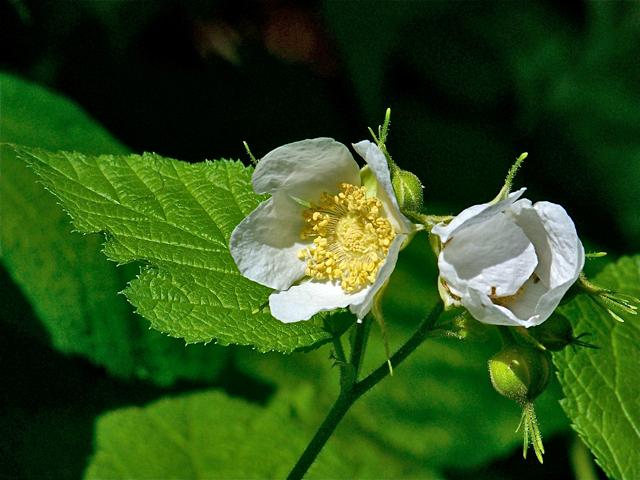
|
Salvia clevelandii
Pronunciation
SAL-vee-uh kleev-LAN-dee-eye
Common Name
Cleveland Sage
Plant Type
Shrub
Mature Size
3 ft. wide and tall
Water Requirements
Very Low: water deeply several times a summer
Sun/Shade Requirements
Full sun
Wildlife
Flower Color
Where to See
Maintenance- Design- Planting Tips
'Winnifred Gilman' is a compact Salvia cultivar with violet-blue flowers that bloom in late spring. The grey-green foliage of this California native smells like a chaparral morning.
Like many sages, these are short-lived plants. Even with regular pruning, Salvia clevelandii needs to be replaced every five to ten years when the stems become woody. PADG Notes: 'Winnifred Gilman' is pruned back by about a third in the late summer and early fall to prolong the life of the plant and maintain a nice shape. To learn more about Salvias, we suggest reading Betsy Clebsch's The New Book of Salvias |
Symphoricarpos albus
Pronunciation
sim-for-ih-KAR-pus AL-bus
Common Name
Snowberry
Plant Type
Shrub
Mature Size
3 - 5 ft. tall and wide
Water Requirements
None: avoid summer water
Sun/Shade Requirements
Full to half sun, shade
Wildlife
Flower Color
Where to See
Maintenance- Design- Planting Tips
When fall and winter come, shrubs with berries and fruit add interest to the garden. Snowberry, a California native, has white berries that show up in the fall and last through winter. These berries are attractive to birds too.
One of the best features of snowberry is it does well in dry woodland conditions. It is a rare shrub that will thrive under a thicket of oak trees. Some people find the branching structure of snowberry to be messy. California Native Plants for the Garden recommends occasional coppicing to improve its appearance. Coppicing means to cut back a plant to about one foot from the ground. This usually works best right before a plant puts out new growth in the spring. PADG Notes: Our snowberries grow in a shady area that gets no summer irrigation.
|
Teucrium fruticans ‘Azureum’
Pronunciation
Tew-kree-um FREW-ti-kanz
Common Name
Bush Germander
Plant Type
Shrub
Mature Size
4 - 6 ft. tall and wide
Water Requirements
Low: water every three weeks until the root ball is wet
Sun/Shade Requirements
Full sun
Wildlife
Flower Color
Violet blue
Where to See
Maintenance- Design- Planting Tips
Teucium fruticans 'Azureum' has attractive blue flowers all winter long. The rest of the year it has a smaller floral display. The deep blue stands out against the grey foliage.
PADG Notes: A drawback to Bush Germander is it can grow to be very large. We pruned ours back to 4 inches to help control its size. The shrub came roaring back with a natural shape and a slightly smaller size. The winter blooms are plentiful. We recently planted a smaller Teucrium cultivar, 'Compactum' that is reputed to stay 3 feet tall and wide and have intense blue flowers. |
Trichostema lanatum
Pronunciation
try-CO-stem-uh la-NAY-tum
Common Name
Woolly Blue Curls
Plant Type
Shrub
Mature Size
3-4 ft. high & wide
Water Requirements
None: avoid summer water
Sun/Shade Requirements
Full sun
Wildlife
Flower Color
Violet to blue
Where to See
Maintenance- Design- Planting Tips
PADG Notes: We approached growing the California native Woolly Blue Curls with some trepidation because it has a reputation for being difficult. It is sensitive to over watering and poor draining soil and often is short lived. But it has beautiful flowers and foliage that smells like bubble gum when rubbed.
Several years ago, a Woolly Blue Curls plant was added to our California native plant bed. The plant was mulched with rock to improve drainage and received no additional summer water. It has bloomed and grown over the years, but it really wants a sunnier spot. The plant is reaching out for more light and has woody, unattractive stems. We’ve avoided cutting the plant back hard, because we have read it does not get new growth on old wood. Some sources suggest planting Woolly Blue Curls as an annual. In all honesty, if your heart is not set on a California native, there are probably easier low water plants with lavender flowers. Lavender and Mexican sage are two lavender flowered plants we think are safer choices for the novice gardener. |
Westringia fruticosa 'Wynyabbie Gem"
Pronunciation
west-RING-ee-uh froo-tih-KOH-suh
Common Name
Coast Rosemary
Plant Type
Shrub
Mature Size
3 - 6 ft. tall and 5 - 10 ft. wide
Water Requirements
Low: water every three weeks until the root ball is wet
Sun/Shade Requirements
Full sun
Wildlife
Flower Color
White to light lavender
Where to See
Maintenance- Design- Planting Tips
This shrub from Australia looks a lot like rosemary, but its leaves are finer and have no fragrance. It has light lavender flowers that appear in midwinter and last through spring.
Westringia grow into large plants so plan ahead or be prepared for a lot of pruning. Unlike rosemary, the stems of Westringia do not get woody, which makes it is a better long term landscaping choice. |







